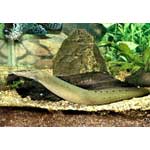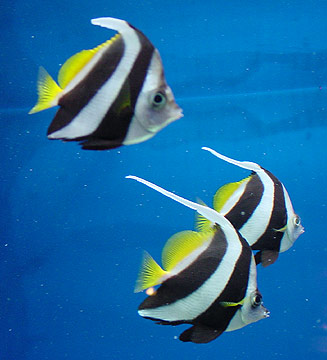Spotted Fin Spiny Eel

|
Scientific Name: Macrognathus siamensis Price: Upon Request Origin: Indonesia, Pakistan, Sumatra and India. Family: Mastacembelidae NOT AVAILABLE NOW |
|
Other Names: Spot-Finned Spiny Eel, Peacock Spiny Eel, Siamese Spiny Eel |
|
Technical Info
Temperature: 24 - 28 ℃
pH: 6.8 - 7.3
GH: 6 - 10
Max size: 76 cm
Min Tank size: 400 Ltr
Position in Aqua: Bottom swimmer
Description
The body of the Peacock Eel is elongated with a pointed snout. Both the dorsal and anal fins are extended back to the caudal fin, which is quite small. There can be some color and pattern variations depending upon it place of origination, but it is primarily light brown in color and it has a thin pale yellow stripe running from the eye to the base of the tail. Its common name "Peacock" Eel is derived from the approximately 3 to 6 ocelli or "eyespots" found along the base of the dorsal fin
Food
The Peacock Eels are carnivores. Like all spiny eels they prefer a diet of live and fresh frozen foods such as brine shrimp, black worms, earthworms or bloodworms. Some spiny eels can be trained to eat freeze dried brine shrimp or bloodworms but this is not something that can be counted on.
Breeding
The Peacock Eel has not been bred in captivity. Only a few spiny eels have been bred in the aquarium, possibly because they are generally kept singly rather than in a group where a male and female can find each other. Though it is not documented what makes them spawn, trying to emulate the bounty of the flood season can help stimulate breeding behavior. Feed more and higher quality food than you normally would and providing an influx of clean water. Their courtship lasts for several hours, where they chase each other and swim in circles. The eggs are deposited among floating plants. They are sticky so will adhere to the plants and then hatch in 3 to 4 days. The fry becoming free swimming a few more days after that and should be fed nauplii. The fry are something of a challenge to raise as they are susceptible to fungal infections. Regular water changes and the use of an antifungal water treatment can help.
Compatible with
Generally peaceful community fish, although care should be taken to ensure tankmates are too large to be considered prey as this species does eat live fish in the wild. It is recommended to only keep one fire eel per tank as they may be aggressive to conspecifics. This can sometimes be avoided by keeping the fish in groups of five or more individuals.

